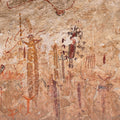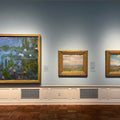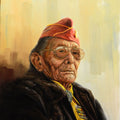James Prosek and the Texas Prairie at Amon Carter Museum of American Art
By Medicine Man Gallery on

Trespassers: James Prosek and the Texas Prairie" installation view at Amon Carter Museum of American Art. Credit: Amon Carter Museum of American Art
Grasslands and prairies don’t get the love of mountains or waterfalls or beaches.
There’s no national park preserving a great native grass prairie drawing millions of tourists a year. No souvenir shops selling “the grasslands are calling, and I must go” doormats. No #prairielife hashtag racking up shares on social media.
Maybe that’s because most people have never seen one. For the lucky few who have, they’ll tell you the waist-high grasses, the blooms, the innumerable birds and bees and butterflies, the biodiversity – the activity – can go toe-to-toe for impact with a redwood forest.
The plow and pavement have consumed them.
Of the 170 million acres of native prairie that covered North America from the Mississippi River to the Rocky Mountains prior to European colonization, only 1% remains.
James Prosek had never seen one before the Amon Carter Museum of American Art in Fort Worth invited him to explore the Texas grasslands for an exhibition which would become, “Trespassers: James Prosek and the Texas Prairie,” on view through January 28, 2024.
“(People have) never been exposed to (native prairie) because most of the land has been changed, I would say destroyed, that might be harsh, but it's not remnant prairie,” Prosek said. “I learned that there are very few of these spaces left where the native prairie grasses and wildflowers grow because most of the land has been changed and cultivated, and now there's corn and soybeans, or it's grazed heavily and (native grasses have been replaced with) some grazing crop, so when I first started visiting remnant prairies like The Nature Conservancy preserve Clymer Meadow in northeast Texas, I was just blown away.”
In addition to being an artist, Prosek is also a naturalist who spent 15 writing a book about freshwater eels. Still, the native grasslands were foreign to him.
“They're an important part of the ecosystem that we've destroyed by overgrazing, fire suppression, development and a host of other things, but they're incredibly beautiful places,” Prosek said. “When you see a native grassland, there's hundreds of species of plants rather than monoculture; every week, something new is blooming. They can be as beautifully diverse as a coral reef or a mountain meadow with wildflowers – just stunning places.”
Prosek is based in Connecticut and had been to Texas previously, but only to the big cities. Two years researching “Trespassers” took him across the state, to the Blackland Prairies northeast of Dallas, Hill Country, south Texas around King Rach, west Texas with the Big Bend and Davis Mountains, the Chihuahuan Desert, Marfa.
“I knew Texas was a big state, but I didn’t know how diverse the habitats were,” he admits.
Matt White, author of “Prairie Time: A Blackland Portrait,” served as guide on of these visits. Many of the remnant prairies he visited were small, survivors of only five or 10 acres. Along the way, he met ranchers, scientists, landscape architects, philanthropists, and ornithologists who share a passion for grassland conservation and restoration.

Trespassers: James Prosek and the Texas Prairie" installation view at Amon Carter Museum of American Art. Credit: Amon Carter Museum of American Art
“Trespassers”
Inspired through these travels, “Trespassers” features new works by Prosek including one of his iconic large-scale silhouette paintings. Texas Prairie Composition No. 1, 8-feet-square, presents a swirling pattern of animal silhouettes, hundreds of species – past and present – native to Texas grasslands.
Also on view are watercolor portraits of plants collected during his travels and tromp l’oeil clay and bronze sculptures of wildflowers and burned logs.
Additionally featured is a site-specific mural, Trespassers No. 1. This companion to Texas Prairie Composition No. 1, takes over two gallery walls with life-size, black-and- white silhouettes of flora and fauna from the Blackland and Trans-Pecos grasslands. In it, a deer is seen jumping over a barbed wire fence.
Here’s where the notion of “Trespass” comes in, alluding to the tension that occurred when Europeans came to colonize previously open and natural places like Texas.
“Europeans had different ideas of landownership, of ownership of what was on the land, they put up property lines, they built fences, but nature, in order to be healthy, needs to move, animals migrate, fire is a trespasser, so the forces that keep nature healthy cross boundaries,” Prosek explains.
Much of his work deals with boundaries. The invisible lines humans draw on the landscape. Like those around Yellowstone National Park he investigated for an exhibition at the Buffalo Bill Center of the West in Cody, WY.
“An elk inside the Park can be protected as a tourist attraction, on the other side, it can be shot as a trophy animal, so even if the lines are invisible – and it's not a fence or a wall – they can still affect the fates of animals as they move and migrate,” Prosek said. “Animals trespass; monarch butterflies pass the Texas-Mexico border every year in their migrations, they don't need a passport. ‘Trespassing’ is a subtle – or not so subtle way – of expressing that the forces that nature needs to be healthy again are boundary breaking.”
Forces interrupted by the fences, walls, barriers, roads, dams, blockades and checkpoints increasingly featured on the North American landscape, and Texas in particular.
“I'm not saying that boundaries are bad, I'm just saying that in order for the grasslands to be healthy, you need a certain amount of trespassing, but once people built houses on the land, you couldn't have a fire that was raging on tens to hundreds of thousands of acres which is what happened – what was intentionally set in the by Indigenous people before the Europeans came,” Prosek said.
“Trespass” encourages visitors to consider who the real “trespassers” are and who’s doing the actual “trespassing?”

Trespassers: James Prosek and the Texas Prairie" installation view at Amon Carter Museum of American Art. Credit: Amon Carter Museum of American Art
Control
Prosek’s travels across Texas also educated him to Native Americans’ productive management of grasslands through fire for millennia, a force of nature white culture took the opposite approach to after asserting dominion over the continent. Throughout the 20th century, America waged war on wildfire from coast to coast, attempting to stamp out every flame, spending trillions of dollars and thousands of lives to suppress a natural process. It took the nation a century to figure out those efforts had the exact opposite effect as intended, that their fire prevention methods made fires worse, and that periodic wildfire is necessary for the health of ecosystems.
Lessons Native people knew, but were not asked to share.
“We're learning that rather than trying to impose our objectives on nature, we have to listen a little bit and it's not easy because our main objectives are usually to try to bend nature to our will, to control it, to harness it – to harness the power of water, the power of wind – but it can come back to bite us,” Prosek said.
By “we’re” and “our,” he means white culture; by “us,” he means everyone.
The historic conflagrations experienced across the West in recent years and Canada in the summer of 2023 are not only the result of climate change and its higher temperatures and draught, they’re the result of a century of flawed forest management practices and fire suppression which prevented occasional smaller wildfires, allowing massive quantities of undergrowth – fuel – to build up and then explode into uncontrollably catastrophic hellscapes.
As necessary as fire is to healthy forests, it’s even more essential to the prairie. Controlled burns are now a standard operating procedure in managing these special places.
Places that impact those who visit them, those who take the time to appreciate their more subtle grandeur. Prosek has been changed by his time on the prairie. He sees the world differently now. He’s reintroducing native grasses around his home and thinking deeply about our shared connection to the grasslands.
“It's something we can't really imagine, the extent of these grasslands, what they looked like,” Prosek said. “Humans evolved in Africa, in big savannas, open grasslands with mixed tree habitat, so maybe it's in all of our genetic makeup to like big open grassland spaces; I've personally fallen in love with them.”



